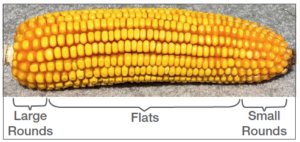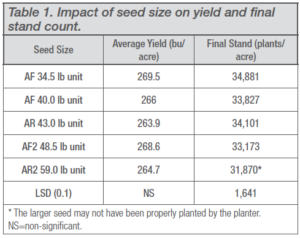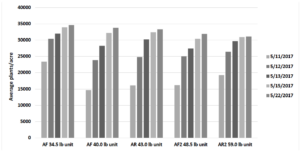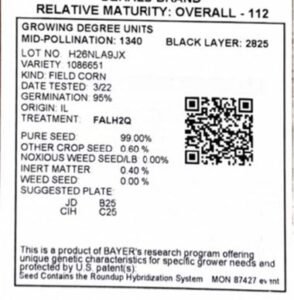Introduction
- The size and shape of a corn seed does not affect its genetic yield potential.
- Corn yield potential is determined by the product’s genetics and can be dramatically affected by management practices and environmental conditions during the growing season.
- All seed, regardless of seed size, shape, or product, are subject to strict quality standards.
Does Seed Size and Shape Affect Yield Potential?
A variety of seed sizes and shapes can come from the same corn product ear. Large rounds typically come from the base of the ear, flats from the center, and small flats and small rounds from the tip (Figure 1).
The size and shape of a corn seed does not affect its genetic yield potential.
All seeds from the same ear, regardless of size or shape have the same genetic material and yield potential. Corn yield potential is determined by genetics but can be dramatically affected by management practices, such as planting into a well-prepared seedbed at the correct planting depth and under optimal soil temperature and moisture. Ensuring proper soil fertility is also critical but ultimately the level of stress throughout the growing season will determine the yield potential of the corn crop.
Decades of research has evaluated the effect of corn seed size on yield potential. Conclusions from these studies have been consistent; corn seed size or shape is not related to genetic yield potential under normal growing conditions.1 A study done at the Bayer Water Utilization Learning Center, Gothenburg, NE in 2017 that measures the yield potential for five different seed sizes of the same corn product and yield differenced were determined to be not significant (Table 1).(2)


Different seed sizes are described along with the corn seed bag weight for 80,000 kernels:
- AF – Medium Flat corn seed
- AR – Medium Round corn seed
- AF2 – Large Flat corn seed
- AR2 – Large Round corn seed
Seed quality is influenced by growing conditions in the seed production field and handling after harvest.
The rate of emergence and seedling vigor under cold environmental conditions can be impacted by the weather conditions experienced when the seed is grown. Stress often affects kernels at the ear tip more severely because they are the last to be pollinated. Since small rounds come from the ear tip, this type of seed can have lower quality due to more exposure to variable environmental conditions. Seed quality can vary from year to year based on the weather throughout the production geography. Seed production areas are selected that provide the best environmental conditions for seed production and facilities are carefully managed to assure that quality is maintained through conditioning and handling.
Large round seeds often have a more exposed embryo than other seed shapes, which make them more susceptible to damage during handling. This physical damage can occur during the seed conditioning process but also by additional seed handling after delivery. Careful handling and movement of seed is important to ensure quality is maintained during the transfer of seed in tendering and planting equipment. Seed is typically handled more today than in the past which can negatively impact seed quality.
Effect of Seed Size and Shape on Emergence and Early Growth
There can be differences in germination related to seed size when conditions after planting are not ideal. Large seed requires more moisture to germinate compared to small seed. Small seed may not emerge as well in cool or crusted soils because it has a smaller reserve of energy stored in the seed. After tasseling, differences in the rate of growth related to seed size are usually no longer apparent. Regardless of seed size and shape, similar silking dates and yield potential are expected when established stands are uniform.3 The same study done by Bayer Water Utilization Learning Center, Gothenburg, NE in 2017 shows the rate of germination can be different for five different evaluation dates for the five different seed sizes (Figure 2).

Figure 2. Average number of plants per acre counted on the five different evaluation dates. (Medium flat, AF 34.5 lb/80,000 kernels, Medium flat, AF 40.0 lb unit/80,000 kernels, Medium round, AR 43.0 lb unit/80,000 kernels, Large flats, AF2 48.5 lb unit/80,000 kernels, Large rounds, AR2 59.0 lb unit/80,000 kernels)
Understanding Quality Control
All seed lots are tested regularly to ensure that the seed adheres to industry-leading quality standards. Some of these tests are needed to meet legal requirements and some are to meet industry or internal quality standards. Before any seed is sold, it goes through cleaning, processing, and a rigorous quality control process, that is printed on the seed tag on each bag or box of seed as outlined below (Figure 3):

Figure 3. Quality control information contained in seed tags includes the seed lot number, physical purity scores, and the date and score of the warm germination test. Also included are planter recommendations for the specific seed type.
Warm Germination Testing
This test is standardized across the industry and can provide a consistent measure of quality for customers when they purchase seed. The germination test measures the germination potential of the seed lot by planting seeds under ideal temperature and moisture conditions. The percent germination that is listed on the seed tag is determined by the warm germination test. Though seeds can remain viable for several years when stored properly, germination testing is conducted every six months when in storage and conducted according to federal seed law requirements to assure that farmers get viable seed with every purchase.
Physical Purity Testing
The physical purity test is conducted to ensure that there are no contaminants in the seed. Physical purity tests address the percentage of pure seed, including Refuge in the Bag requirements, other crop seeds, noxious weeds, inert matter and other weed seeds. This test is standardized across the industry to provide a consistent measure of quality for customers.
Genetic Purity Testing
This test utilizes molecular analyses to ensure that the product contains the herbicide and insect traits at the correct labeled levels.
Planter Information
This information is provided to suggest the planter plate for this seed type when the customer uses a plate type planter.
Storage Consideration
The two most important factors that affect seed viability are moisture and temperature. After cleaning, processing, and quality control, all corn seed is stored in moisture resistant packages and temperatures are carefully monitored during storage to ensure the best environment for maximum seed viability. Once seed leaves the conditioning facilities dealers and customers should also take the necessary steps to prevent their seed from being exposed to moisture, excessive temperature fluctuations, high temperatures, rodents, or other pests.
Management of Different Seed Sizes
Seed companies typically sell corn seed based on shape and size and list the bag weight for that seed size grade and lot. The weight of a bag of seed is what that bag will weigh when filled with 80,000 (80K) kernels, which is currently the industry standard. Farmers historically purchased specific seed shapes, sizes and weights which was based on how their planters were configured. With the industry going to vacuum or pressure delivery systems, instead of plate type planters, it is now often more common for producers to request seed lots that are close to the same bag weight to reduce the need for planter adjustment going from one seed lot or type to another. When properly managed and properly positioned, corn seed of any size and weight can produce a successful crop.
- Planter settings should be adjusted for accurate seed positioning, placement, and seeding rate based on the size and shape of the seed. When adjusted for seed size, a planter can more accurately singulate and deliver seed. Planters can deliver excessive numbers of doubles or skips when improperly adjusted for seed size.
- Plant seed according to soil temperature and moisture conditions. If there are concerns about seed size and germination, consider waiting to plant until conditions are conducive to rapid germination, emergence and early growth.
- Understand how different soil types and conditions in your field can affect seedling emergence and early growth.
Understanding the ratings in the product guides
The emergence and seedling vigor ratings found in a seed guide are determined through field observations of performance throughout the development of the product. Corn products can have different response to environmental factors like soil conditions, seedling diseases, cold weather and other factors because of genetic differences. Vigor tests (as an example cold germination) are used to predict which seed will perform best in a wide range of challenging conditions. The vigor test score doesn’t predict how many viable plants will grow in every field. A vigor test score is typically much lower than the warm germination score because of the severity of stress in the vigor test. While the warm germination test indicates the percentage of the seed that will germinate under ideal conditions; the seedling vigor test indicates the percentage of plants with acceptable growth under stressful conditions. Many environmental conditions that are not part of these tests, such as the length of time the seed is in the soil before emergence and soil temperature fluctuations which can have a direct impact on actual field performance. Vigor tests are not standardized across the industry and are adjusted on a regular basis to manage changes in corn products, seed treatments, and grower practices. Bayer closely monitors the field performance of its seed and makes annual adjustments to respond to changing customer needs. In the final analysis instead of focusing on seed size and shape, the focus should be on selecting hybrids with the best performance and sound agronomic traits.(3)
Sources
1 Nielsen, R.L. 1996. Seed Size, Seed Quality, and Planter Adjustments. Agronomy Department, Purdue University. https://www.agry.purdue.edu/ext/corn/news/articles.96/p&c9606.htm#:~:text=In%20practice%2C%20seed%20size%20and%20shape%20can%20 also%20influence%20yield,to%2010%20bushels%20per%20acre.
2 Impact of corn seed size and shape on yield potential. 2017 Regional Report. Bayer Learning Center at Gothenburg, NE.
3 2005. Kernel size and shape. Iowa State University. Integrated Crop Management. https://crops.extension.iastate.edu/encyclopedia/kernel-size-and-shape.
Web sources verified 02/21/22.
Legal Statements
ALWAYS READ AND FOLLOW PESTICIDE LABEL DIRECTIONS. Performance may vary, from location to location and from year to year, as local growing, soil and weather conditions may vary. Growers should evaluate data from multiple locations and years whenever possible and should consider the impacts of these conditions on the grower’s fields.
Bayer is a registered trademark of Bayer Group. ©2022 Bayer Group. All rights reserved. 1015_S6_
